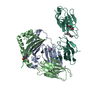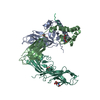+ Open data
Open data
- Basic information
Basic information
| Entry | Database: PDB / ID: 9cym | |||||||||
|---|---|---|---|---|---|---|---|---|---|---|
| Title | Structure of LAG3 bound to the MHC class II molecule I-A(b) | |||||||||
 Components Components |
| |||||||||
 Keywords Keywords | IMMUNE SYSTEM / LAG3 / MHC class II / Immune checkpoint / T cell | |||||||||
| Function / homology |  Function and homology information Function and homology informationpositive regulation of antigen processing and presentation / positive regulation of alpha-beta T cell activation / negative regulation of peptide secretion / macrophage migration inhibitory factor signaling pathway / NOS2-CD74 complex / MHC class II protein binding, via antigen binding groove / antigen processing and presentation of endogenous antigen / positive regulation of dendritic cell antigen processing and presentation / plasmacytoid dendritic cell activation / macrophage migration inhibitory factor binding ...positive regulation of antigen processing and presentation / positive regulation of alpha-beta T cell activation / negative regulation of peptide secretion / macrophage migration inhibitory factor signaling pathway / NOS2-CD74 complex / MHC class II protein binding, via antigen binding groove / antigen processing and presentation of endogenous antigen / positive regulation of dendritic cell antigen processing and presentation / plasmacytoid dendritic cell activation / macrophage migration inhibitory factor binding / negative regulation of T cell differentiation / positive regulation of macrophage migration inhibitory factor signaling pathway / protein trimerization / macrophage migration inhibitory factor receptor complex / negative regulation of regulatory T cell differentiation / positive regulation of cytokine-mediated signaling pathway / positive regulation of T-helper 1 type immune response / positive regulation of prostaglandin biosynthetic process / T cell activation involved in immune response / T cell selection / positive regulation of type 2 immune response / antigen processing and presentation of peptide antigen / negative regulation of T cell activation / B cell affinity maturation / positive regulation of natural killer cell mediated cytotoxicity / host-mediated suppression of symbiont invasion / negative thymic T cell selection / MHC class II protein binding / negative regulation of mature B cell apoptotic process / MHC class II antigen presentation / positive regulation of kinase activity / protein antigen binding / positive regulation of monocyte differentiation / positive thymic T cell selection / vacuole / CD4 receptor binding / cytokine receptor activity / positive regulation of neutrophil chemotaxis / positive regulation of chemokine (C-X-C motif) ligand 2 production / prostaglandin biosynthetic process / positive regulation of macrophage cytokine production / positive regulation of T cell differentiation / negative regulation of interleukin-2 production / natural killer cell mediated cytotoxicity / transport vesicle membrane / regulation of macrophage activation / negative regulation of intrinsic apoptotic signaling pathway in response to DNA damage by p53 class mediator / antigen processing and presentation / nitric-oxide synthase binding / cytokine binding / negative regulation of DNA damage response, signal transduction by p53 class mediator / : / immunoglobulin mediated immune response / response to type II interferon / regulation of immune response / toxic substance binding / positive regulation of chemokine production / positive regulation of B cell proliferation / multivesicular body / protein folding chaperone / MHC class II antigen presentation / lysosomal lumen / negative regulation of cell migration / T cell activation / trans-Golgi network membrane / Cell surface interactions at the vascular wall / positive regulation of interleukin-8 production / lumenal side of endoplasmic reticulum membrane / intracellular protein transport / MHC class II protein complex / clathrin-coated endocytic vesicle membrane / ER to Golgi transport vesicle membrane / antigen processing and presentation of exogenous peptide antigen via MHC class II / peptide antigen binding / cellular response to type II interferon / positive regulation of interleukin-6 production / positive regulation of protein phosphorylation / positive regulation of fibroblast proliferation / MHC class II protein complex binding / endocytic vesicle membrane / transmembrane signaling receptor activity / late endosome / amyloid-beta binding / protein-containing complex assembly / adaptive immune response / positive regulation of viral entry into host cell / early endosome / cell surface receptor signaling pathway / positive regulation of ERK1 and ERK2 cascade / lysosome / positive regulation of canonical NF-kappaB signal transduction / positive regulation of MAPK cascade / protein stabilization / immune response / Golgi membrane / lysosomal membrane / external side of plasma membrane / ubiquitin protein ligase binding / positive regulation of gene expression / negative regulation of apoptotic process Similarity search - Function | |||||||||
| Biological species |   Homo sapiens (human) Homo sapiens (human) | |||||||||
| Method |  X-RAY DIFFRACTION / X-RAY DIFFRACTION /  SYNCHROTRON / SYNCHROTRON /  MOLECULAR REPLACEMENT / Resolution: 3.84 Å MOLECULAR REPLACEMENT / Resolution: 3.84 Å | |||||||||
 Authors Authors | Ming, Q. / Antfolk, D. / Tran, T.H. / Luca, V.C. | |||||||||
| Funding support |  United States, 2items United States, 2items
| |||||||||
 Citation Citation |  Journal: Nat Commun / Year: 2024 Journal: Nat Commun / Year: 2024Title: Structural basis for mouse LAG3 interactions with the MHC class II molecule I-A b. Authors: Ming, Q. / Antfolk, D. / Price, D.A. / Manturova, A. / Medina, E. / Singh, S. / Mason, C. / Tran, T.H. / Smalley, K.S.M. / Leung, D.W. / Luca, V.C. | |||||||||
| History |
|
- Structure visualization
Structure visualization
| Structure viewer | Molecule:  Molmil Molmil Jmol/JSmol Jmol/JSmol |
|---|
- Downloads & links
Downloads & links
- Download
Download
| PDBx/mmCIF format |  9cym.cif.gz 9cym.cif.gz | 315.3 KB | Display |  PDBx/mmCIF format PDBx/mmCIF format |
|---|---|---|---|---|
| PDB format |  pdb9cym.ent.gz pdb9cym.ent.gz | 215.8 KB | Display |  PDB format PDB format |
| PDBx/mmJSON format |  9cym.json.gz 9cym.json.gz | Tree view |  PDBx/mmJSON format PDBx/mmJSON format | |
| Others |  Other downloads Other downloads |
-Validation report
| Summary document |  9cym_validation.pdf.gz 9cym_validation.pdf.gz | 1.1 MB | Display |  wwPDB validaton report wwPDB validaton report |
|---|---|---|---|---|
| Full document |  9cym_full_validation.pdf.gz 9cym_full_validation.pdf.gz | 1.1 MB | Display | |
| Data in XML |  9cym_validation.xml.gz 9cym_validation.xml.gz | 23.9 KB | Display | |
| Data in CIF |  9cym_validation.cif.gz 9cym_validation.cif.gz | 31.5 KB | Display | |
| Arichive directory |  https://data.pdbj.org/pub/pdb/validation_reports/cy/9cym https://data.pdbj.org/pub/pdb/validation_reports/cy/9cym ftp://data.pdbj.org/pub/pdb/validation_reports/cy/9cym ftp://data.pdbj.org/pub/pdb/validation_reports/cy/9cym | HTTPS FTP |
-Related structure data
| Related structure data |  9cylC C: citing same article ( |
|---|---|
| Similar structure data | Similarity search - Function & homology  F&H Search F&H Search |
- Links
Links
- Assembly
Assembly
| Deposited unit | 
| ||||||||||
|---|---|---|---|---|---|---|---|---|---|---|---|
| 1 |
| ||||||||||
| Unit cell |
|
- Components
Components
| #1: Protein | Mass: 25711.383 Da / Num. of mol.: 1 Source method: isolated from a genetically manipulated source Source: (gene. exp.)   Trichoplusia ni (cabbage looper) / References: UniProt: Q61790 Trichoplusia ni (cabbage looper) / References: UniProt: Q61790 | ||||
|---|---|---|---|---|---|
| #2: Protein | Mass: 22026.480 Da / Num. of mol.: 1 Source method: isolated from a genetically manipulated source Source: (gene. exp.)   Trichoplusia ni (cabbage looper) / References: UniProt: P14434 Trichoplusia ni (cabbage looper) / References: UniProt: P14434 | ||||
| #3: Protein/peptide | Mass: 1733.170 Da / Num. of mol.: 1 Source method: isolated from a genetically manipulated source Source: (gene. exp.)  Homo sapiens (human) / Gene: CD74, DHLAG / Production host: Homo sapiens (human) / Gene: CD74, DHLAG / Production host:  Trichoplusia ni (cabbage looper) / References: UniProt: P04233 Trichoplusia ni (cabbage looper) / References: UniProt: P04233 | ||||
| #4: Protein | Mass: 22580.168 Da / Num. of mol.: 1 Source method: isolated from a genetically manipulated source Source: (gene. exp.)   Trichoplusia ni (cabbage looper) / References: UniProt: P14483 Trichoplusia ni (cabbage looper) / References: UniProt: P14483 | ||||
| #5: Sugar | ChemComp-NAG / Has ligand of interest | Y | Has protein modification | Y | |
-Experimental details
-Experiment
| Experiment | Method:  X-RAY DIFFRACTION / Number of used crystals: 1 X-RAY DIFFRACTION / Number of used crystals: 1 |
|---|
- Sample preparation
Sample preparation
| Crystal | Density Matthews: 4.19 Å3/Da / Density % sol: 70.62 % |
|---|---|
| Crystal grow | Temperature: 293.15 K / Method: vapor diffusion, sitting drop / pH: 8 Details: 0.15 M Ammonium sulfate, 0.1 M Tris 8.0 and 15 % w/v PEG 4000 |
-Data collection
| Diffraction | Mean temperature: 100 K / Serial crystal experiment: N | ||||||||||||||||||||||||||||||||||||||||||||||||||||||||||||||||||||||||||||||||||||||||||||||||||||||||||||||||||||||||
|---|---|---|---|---|---|---|---|---|---|---|---|---|---|---|---|---|---|---|---|---|---|---|---|---|---|---|---|---|---|---|---|---|---|---|---|---|---|---|---|---|---|---|---|---|---|---|---|---|---|---|---|---|---|---|---|---|---|---|---|---|---|---|---|---|---|---|---|---|---|---|---|---|---|---|---|---|---|---|---|---|---|---|---|---|---|---|---|---|---|---|---|---|---|---|---|---|---|---|---|---|---|---|---|---|---|---|---|---|---|---|---|---|---|---|---|---|---|---|---|---|---|
| Diffraction source | Source:  SYNCHROTRON / Site: SYNCHROTRON / Site:  SSRL SSRL  / Beamline: BL12-1 / Wavelength: 0.9794 Å / Beamline: BL12-1 / Wavelength: 0.9794 Å | ||||||||||||||||||||||||||||||||||||||||||||||||||||||||||||||||||||||||||||||||||||||||||||||||||||||||||||||||||||||||
| Detector | Type: DECTRIS EIGER X 16M / Detector: PIXEL / Date: Mar 21, 2024 | ||||||||||||||||||||||||||||||||||||||||||||||||||||||||||||||||||||||||||||||||||||||||||||||||||||||||||||||||||||||||
| Radiation | Protocol: SINGLE WAVELENGTH / Monochromatic (M) / Laue (L): M / Scattering type: x-ray | ||||||||||||||||||||||||||||||||||||||||||||||||||||||||||||||||||||||||||||||||||||||||||||||||||||||||||||||||||||||||
| Radiation wavelength | Wavelength: 0.9794 Å / Relative weight: 1 | ||||||||||||||||||||||||||||||||||||||||||||||||||||||||||||||||||||||||||||||||||||||||||||||||||||||||||||||||||||||||
| Reflection | Resolution: 3.84→38.61 Å / Num. obs: 12347 / % possible obs: 96.6 % / Redundancy: 10 % / Biso Wilson estimate: 133 Å2 / CC1/2: 0.999 / Rmerge(I) obs: 0.199 / Rrim(I) all: 0.21 / Net I/σ(I): 11.49 | ||||||||||||||||||||||||||||||||||||||||||||||||||||||||||||||||||||||||||||||||||||||||||||||||||||||||||||||||||||||||
| Reflection shell |
|
- Processing
Processing
| Software |
| ||||||||||||||||||||||||||||||||||||||||
|---|---|---|---|---|---|---|---|---|---|---|---|---|---|---|---|---|---|---|---|---|---|---|---|---|---|---|---|---|---|---|---|---|---|---|---|---|---|---|---|---|---|
| Refinement | Method to determine structure:  MOLECULAR REPLACEMENT / Resolution: 3.84→38.61 Å / SU ML: 1.2004 / Cross valid method: FREE R-VALUE / σ(F): 1.33 / Phase error: 50.5982 MOLECULAR REPLACEMENT / Resolution: 3.84→38.61 Å / SU ML: 1.2004 / Cross valid method: FREE R-VALUE / σ(F): 1.33 / Phase error: 50.5982 Stereochemistry target values: GeoStd + Monomer Library + CDL v1.2
| ||||||||||||||||||||||||||||||||||||||||
| Solvent computation | Shrinkage radii: 0.9 Å / VDW probe radii: 1.1 Å / Solvent model: FLAT BULK SOLVENT MODEL | ||||||||||||||||||||||||||||||||||||||||
| Displacement parameters | Biso mean: 234.31 Å2 | ||||||||||||||||||||||||||||||||||||||||
| Refinement step | Cycle: LAST / Resolution: 3.84→38.61 Å
| ||||||||||||||||||||||||||||||||||||||||
| Refine LS restraints |
| ||||||||||||||||||||||||||||||||||||||||
| LS refinement shell |
| ||||||||||||||||||||||||||||||||||||||||
| Refinement TLS params. | Method: refined / Origin x: -2.22828682959 Å / Origin y: -73.0049892443 Å / Origin z: 5.13767024764 Å
| ||||||||||||||||||||||||||||||||||||||||
| Refinement TLS group | Selection details: all |
 Movie
Movie Controller
Controller



 PDBj
PDBj











